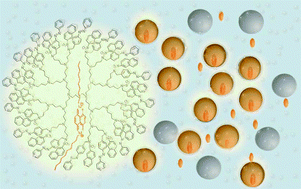A fluorescent guest encapsulated by a photoreactive azobenzene dendrimer
Abstract
We have studied the

* Corresponding authors
a
Dipartimento di Chimica “G. Ciamician”, Università di Bologna, via Selmi 2, I-40126 Bologna, Italy
E-mail:
paola.ceroni@unibo.it
Fax: +39 051 2099456
Tel: +39 051 2099535
b
Kekulé-Institut für Organische Chemie und Biochemie der Universität Bonn, Gerhard-Domagk Strasse 1, D-53121 Bonn, Germany
E-mail:
voegtle@uni-bonn.de
Fax: +49 228 735662
Tel: +49 228 733496
We have studied the

 Please wait while we load your content...
Something went wrong. Try again?
Please wait while we load your content...
Something went wrong. Try again?
F. Puntoriero, G. Bergamini, P. Ceroni, V. Balzani and F. Vögtle, New J. Chem., 2008, 32, 401 DOI: 10.1039/B718095K
To request permission to reproduce material from this article, please go to the Copyright Clearance Center request page.
If you are an author contributing to an RSC publication, you do not need to request permission provided correct acknowledgement is given.
If you are the author of this article, you do not need to request permission to reproduce figures and diagrams provided correct acknowledgement is given. If you want to reproduce the whole article in a third-party publication (excluding your thesis/dissertation for which permission is not required) please go to the Copyright Clearance Center request page.
Read more about how to correctly acknowledge RSC content.
 Fetching data from CrossRef.
Fetching data from CrossRef.
This may take some time to load.
Loading related content
